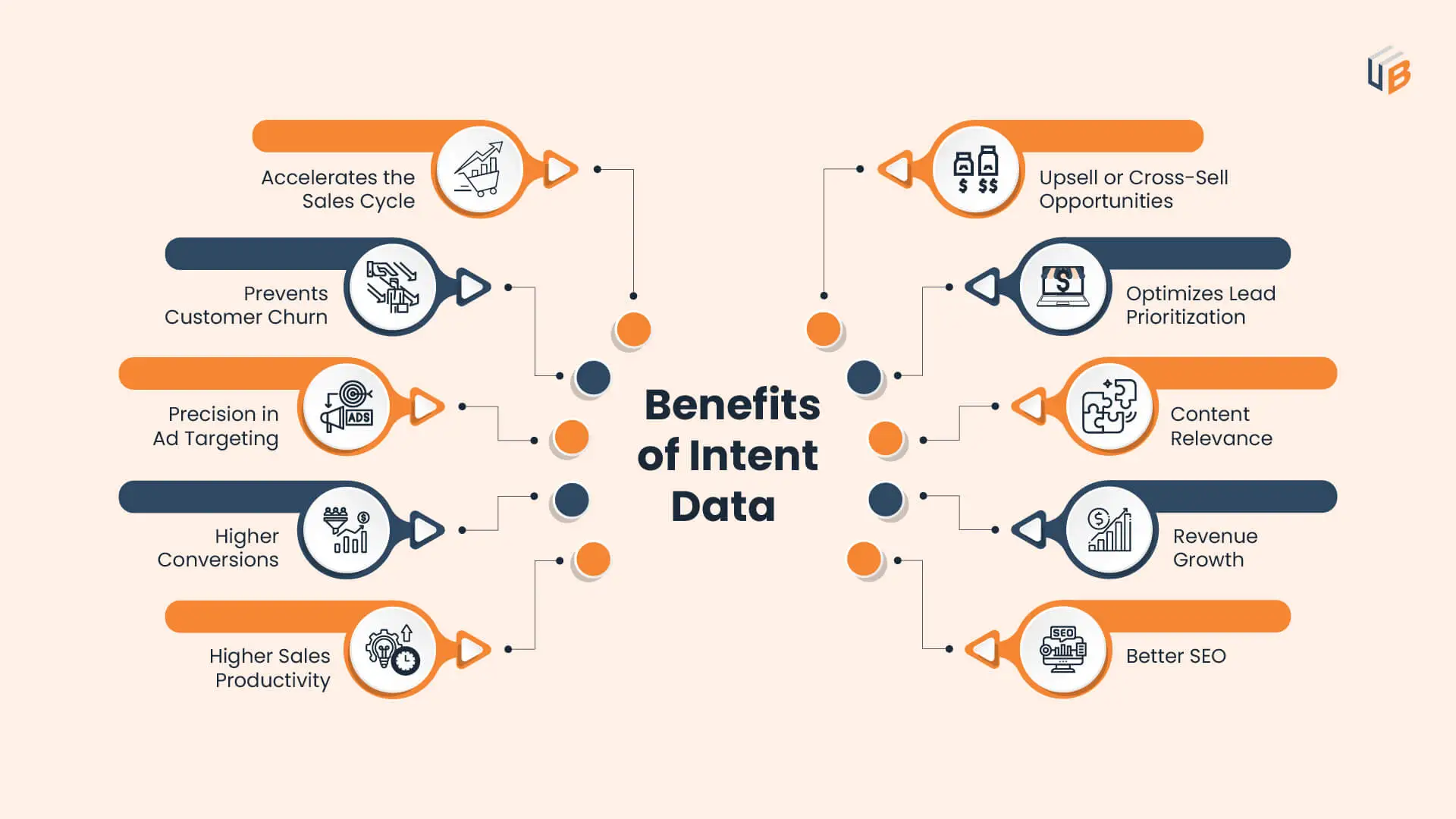
In today’s highly dynamic business environment, B2B marketers must understand their target audience to stay competitive. As a B2B marketer, the only way to have the right conversation with potential customers is to have their basic information, behavioural patterns and interests through all the online activities. Access to this information is one of the most crucial aspects of using intent data.
B2B intent data helps marketers understand what motivates prospects to purchase certain products or services and when they’re likely to buy in the near future. Applied correctly, these insights can empower your team to craft smart marketing strategies.
In this article, we discuss intent-based marketing and show you 10 key benefits of intent data your company can reap in 2024.
But first, What is Intent Data Marketing?
Intent-based marketing refers to the super-focused strategy that involves analyzing online buyer intent and customizing marketing messages like offers and content automatically. This marketing approach is increasingly becoming an integral part of B2B advertising, customer retention, and user-experience strategies.
Marketers use intent data to persuade shoppers with the highest likelihood of buying a product or service to make purchase decisions. Various variables are used to determine customer intent. These include browsing history, the length of time users spend on specific web pages, and the pages they visit next.
What is the Power of Intent Data?
Intent data provides insights about potential customers. It can give you an idea of what your prospects’ problems are, what they are currently researching, and how ready they are to interact with your brand. Insights about online buyer behaviour and intentions enable you to customize marketing efforts to suit the interests, needs, and preferences.
What Benefits Can Intent Data Provide?
Below are 10 key benefits of intent data to power smarter marketing strategies in 2024:

1. Accelerates the Sales Cycle
Fast-tracking the sales process is among the major benefits of intent data. B2B marketers can accelerate the sales cycle with intent data by identifying high-quality leads and improving messaging and timing. Intent data helps you identify prospects that are actively searching for solutions your company offers. You understand the problems they have, the products they’re looking at, and when they’re ready to engage with your brand. These insights enable you to deliver the right messages to the right individuals at the right time, which shortens the sales cycle.
2. Upsell or Cross-Sell Opportunities
Intent data helps you to know what your current customers are researching and identify opportunities to upsell or cross-sell them. For instance, this data can show which other products or features your customers are researching. If you find a customer researching a product you offer or features not covered by the current license, cross-sell or upsell them.
3. Prevents Customer Churn
It costs companies 5 times more to acquire a new customer than to retain an existing one. Intent data helps in retaining current customers longer. Since it gives insights into what prospects are researching, marketers can tell when current customers start considering competitor solutions. They can take steps like personalized engagements to address product/service gaps that could lead to customer churn.
4. Optimizes Lead Prioritization
When it comes to smart marketing, lead prioritization is among the key benefits of intent data. Poor lead prioritization can result in engagement of low-quality leads or disinterested buyers. Intent data eliminates this risk by giving you a glimpse of prospect intent. These insights allow you to score leads more accurately and focus your lead-nurturing efforts on the right ones. Sales teams prioritize prospects that demonstrate strong intent to convert them faster.
5. Precision in Ad Targeting
Intent data can enhance ad efficiency for B2B marketers. By revealing prospects’ buying stage, needs, and interests, marketers can deliver programmatic ads to potential buyers with precision. Knowing prospect needs allows marketers to target the right decision-makers with ads, eliminating guesswork in advertising. This increases clickthrough rates and optimizes ad spend.
6. Content Relevance
Another way intent data benefits marketers is by providing insights on topics that prospects are researching. With this knowledge, you can understand the needs and interests of your target decision-makers and develop a content strategy that ensures the distribution of relevant content. Segment email lists and deliver personalized content based on your prospects’ intent. Apply this strategy to your website content- develop custom landing pages and messages targeting specific audience sizes, needs, or interests.
7. Higher Conversions
Use intent data to identify and monitor prospects that are already showing an intention to buy. Such prospects are easier to convert. Customize marketing messages to resonate with their interests and needs. Schedule sales and marketing outreaches to reach them at the right time to boost conversions.
8. Revenue Growth
Since intent data empowers marketing teams to determine buyer intent and focus on high-quality prospects, they don’t waste time, money, and effort on leads that aren’t ready to buy. With increased conversations, companies also increase their revenue flow.
9. Higher Sales Productivity
Hubspot stats show that 40% of sales reps struggle with prospecting. Intent data eliminates this barrier by enabling sales teams to identify and evaluate prospects with purchase intent. This means they can focus on converting the right prospects, which increases their productivity.
10. Better SEO
You can use intent data to support your SEO efforts. Get insights on the keywords and phrases your prospects use to search the internet then customize ads and content to target prospects. Doing this can improve ad efficiency and improve conversions.
How Intent Data Can Boost Your Marketing Efforts
Intent data has always assisted marketers in understanding prospects’ decision-making and buying patterns. As you have witnessed above the multiple benefits of intent data, it can become lucrative for your business. With UnboundB2B’s intent marketing, you can deepen your connection with your prospects and enhance your marketing strategy.

FAQs
Why is intent data important?
Intent data helps you to predict whether a prospect intends to buy your product or not. This information enables you to make efficient marketing decisions.
Who uses intent data?
Intent data is mostly used by sales and marketing teams to identify nurture, and convert prospects. Customer success and service teams can use it to improve customer experience as well.
What is an example of intent data?
Leading examples of intent data include purchase history, search queries, website browsing history, and social media posts.
What can you do with intent data?
You can use intent data to improve your marketing efforts. These include scoring leads, targeting ads to the right prospects, creating compelling content, and personalizing prospect engagement.
Our blog
Latest blog posts
Tool and strategies modern teams need to help their companies grow.

It is for fact that today's buying environment demands more. With longer sales cycles...

To build a marketing strategy that drives real results, you need more than creative i...

The 95/5 rule in B2B marketing shows that while only 5% of buyers are ready to purcha...






